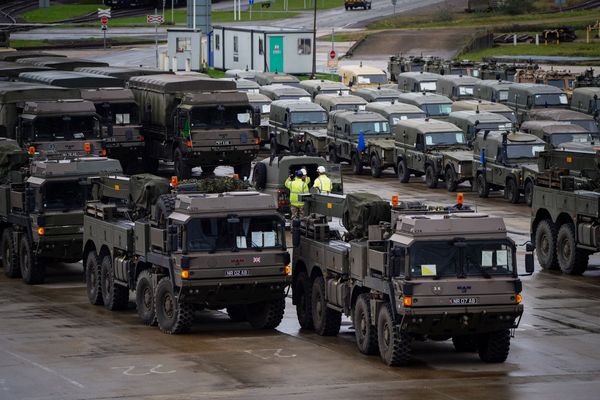
On Dec. 15, 1971, the USS Enterprise, the largest aircraft carrier in the U.S. Navy at the time, entered the Bay of Bengal as the spearhead of a naval task force of the U.S. 7th Fleet. The task force had been dispatched to help evacuate beleaguered Pakistani forces in East Pakistan as the Indian military steadily advanced toward Dhaka, the regional capital. But Dhaka fell to Indian forces on Dec. 16, and the task force’s entry into the Bay of Bengal seemed to be futile. East Pakistan soon became Bangladesh, and India gained a grateful new regional ally.
Washington’s main goal, it turned out, was to send a signal to Islamabad and Beijing that it was a reliable ally that would stand by its commitments at a time of need. The message to China was especially important because Henry Kissinger, then-secretary of state, had recently made a clandestine trip to Beijing using Islamabad as an interlocutor. Kissinger’s mission, as is now well known, was the opening gambit in Richard Nixon’s outreach to China.
Indian policymakers knew about these motivations, but they didn’t forget Washington’s great show of might: They would remember it as an act designed to intimidate them.
Decades later, the episode still deeply rankled policymakers in New Delhi. In its wake, some, most notably India’s leading strategist of the time, K. Subrahmanyam, even argued that India should pursue nuclear weapons to ensure that no country could again have the ability to threaten it. And in subsequent years, in official U.S.-India meetings, the incident almost invariably affected the tenor of discussions.
In world politics, however, the worm often turns, even if very, very slowly. Last month, a contingent of U.S. warships carried out a naval exercise with their Indian counterparts near the Andaman and Nicobar Islands in the Bay of Bengal. The stated objective of the exercise was to enhance military interoperability and training. Left unstated was that the exercise, which saw the United States deploy the USS Nimitz, its nuclear-powered aircraft carrier, took place against a backdrop of growing Sino-Indian tensions along the Himalayan border. Skirmishes in May and June had resulted in the loss of lives of both Chinese and Indian forces. They also led U.S. Secretary of State Mike Pompeo to reprimand China for its “incredibly aggressive” actions.
The contrast between the two episodes in the Bay of Bengal—nearly 50 years apart—underscores how dramatically U.S.-India security ties have evolved. The basis of the transformation, perhaps, began with the 2008 U.S.-India civilian nuclear agreement under the George W. Bush administration. The deal, for all practical purposes, recognized India as a de facto nuclear weapons state. Since then there has been substantial growth in military-to-military contacts and a spurt of arms sales to India. The relationship has now acquired a distinct strategic ballast.
What then is the principal basis for this strategic convergence between two states that were mostly at odds with each other during much of the Cold War? The answer is quite straightforward: It can be attributed to shared misgivings about China’s growing aggressiveness across much of Asia. Despite a spate of efforts on the part of the Narendra Modi government in India to improve relations with China, including the staging of two high-level summits at Wuhan and then in Chennai, it had made little headway. Instead, clashes with China’s army along the so-called Line of Actual Control in May and June highlighted the limits of India’s diplomatic overtures. The border incidents shocked Modi’s government into reassessing its entire approach toward its northern neighbor. Clearly, expanding trade ties and diplomatic outreach had done little to improve the security issues dividing the two countries.
Not surprisingly, in the wake of the border incidents, India expedited the acquisition of the Rafale fighter jets that it had contracted to buy from France. (Five such jets arrived in India last week, to great media fanfare.) Defense Minister Rajnath Singh also dashed off to Moscow, one of India’s principal defense suppliers, to acquire more MiG-29s and Sukhoi Su-30 aircraft. These frantic efforts underscored India’s acute sense of threat from China. After all, despite the bluster common in Indian media, New Delhi is aware of its standing compared with Beijing. India’s defense budget is a less than a third of China’s, its GDP is one-fifth the size of China’s, and it has a much smaller standing military force. And the reality is that India has no possible pathway to swiftly augment its military capabilities to catch up and cope with China.
Short of capitulating to China on its border dispute, India has no choice but to turn to what scholars of international relations refer to as external balancing—seeking the support of a more powerful state to secure one’s national security interests. This explains India’s newfound willingness to expand the scope of its existing military-to-military cooperation with the United States. In turn, the United States, which has witnessed China’s increasing aggressiveness from the South China Sea to the Taiwan Straits and now in the Himalayas, has powerful incentives to bolster its strategic partnership with India. India’s naval assets as well as its base facilities in the Indian Ocean make it a useful partner.
Is this security partnership likely to endure? Given India’s position, with China encircling it by deepening ties with countries such as Bangladesh, Nepal, Pakistan, and Sri Lanka, there is every reason to believe that the relationship will not only be sustained but deepened. In reality, India has no other good options. Russia, though an important weapons supplier, has little or no interest in bolstering India’s security. Moscow’s willingness to sell weaponry at short notice does not stem from any particular affinity for New Delhi but reflects its commercial interests. And these acquisitions are, at best, stopgap measures for India. To tackle the security threat posed by China, India needs a long-term strategy. A security partnership with the United States is the only viable option.
It is all but evident that the Modi government recognizes India’s security predicament and the need to work with the United States. Should a Congress government, were it to come to power in India in 2024, fundamentally change course? Admittedly, some within its ranks still entertain fond hopes of resurrecting their old doctrine of nonalignment. They would, no doubt, caution against an excessive reliance on the United States to protect India’s security. But as the threat from China grows—as now seems very likely—it is easy to imagine a bipartisan Indian support for a continued partnership with the United States.
It is unlikely that the United States will change course either. Despite dramatic foreign-policy shifts from the Obama years to the Trump administration, there has been remarkable policy continuity toward both China and India. Shared concerns about the dramatic rise and aggressiveness of China constitute the principal impetus underlying this partnership. However, unlike in the past, the U.S.-India relationship has become multifaceted, making it all the more likely to endure.
India and the United States, unlike in 1971, now confront a common challenge to their security interests. As the 19th-century British diplomat and prime minister Lord Palmerston once stated, countries have no permanent friends or enemies, just enduring interests. Today, the security interests of India and the United States have neatly dovetailed. The worm has indeed turned.







